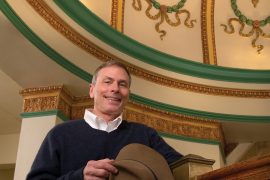By Jack Houvouras
HQ 40 | AUTUMN 2000
Perhaps former President Woodrow Wilson said it best when he penned the phrase, “No man that does not see visions will ever realize any high hope or undertake any high enterprise.”
In this edition of the Huntington Quarterly, the impact of vision is clearly evident. The stories of three unique Huntingtonians are told and each has possessed a clear vision of the future.
In our cover story of Genesis C.E.O. J. Thomas Jones, we profile a true leader. In the last ten years, Jones has not only helped transform healthcare throughout the region, but has emerged as one of the community’s most dynamic leaders. In his role at Genesis he has brought to fruition his vision for a unified healthcare system, counting St. Mary’s, Cabell Huntington and Pleasant Valley hospitals among the current members of the organization. His plans call for improved healthcare for all, reduced costs and growing the organization to include up to eight hospitals in the coming months and years. Today, Genesis is the largest hospital system in West Virginia.
In his role as civic leader, Jones has involved himself in virtually every facet of community betterment and is widely regarded as one of the region’s strongest leaders.
Another Huntington visionary that has been working quietly behind the scenes over the years is John Hankins. An attorney by trade, Hankins has almost single-handedly taken it upon himself to transform the aesthetics of the area through his brilliant architectural renovations. In part one of a series, we examine his most recent undertaking — the restoration of the Guaranty Bank and Trust building on Ninth Street. In future issues, we will feature many of his other projects, including the renovations of such Huntington icons as Hibachi restaurant, the old Herald-Dispatch building, the Cabell County Courthouse and downtown Barboursville, just to name a few. And Hankins isn’t done yet. His vision for the future is to continue renovating many of the region’s architectural gems, one project at a time.
Finally, we profile former Huntington Mayor Rufus Switzer (1855-1947) who, in my opinion, was the greatest visionary in the city’s history.
Although not a well-known name to most Huntingtonians, Switzer was a successful businessman, attorney, politician and civic leader who was said to have been motivated by one driving interest in life — the betterment of the community. He left behind as part of his legacy the establishment of Ritter Park, the Huntington Museum of Art, the Huntington Clinical Foundation, Inc. and years of service as a true public servant. His life’s work impacted us all through improved recreation, culture, art, health and government.
While many leaders speak of their vision of the future, few possess the ability to maintain focus. Fewer still have the capacity and drive to transform their dreams into reality. These three men did. And for that, Huntington is all the richer.





